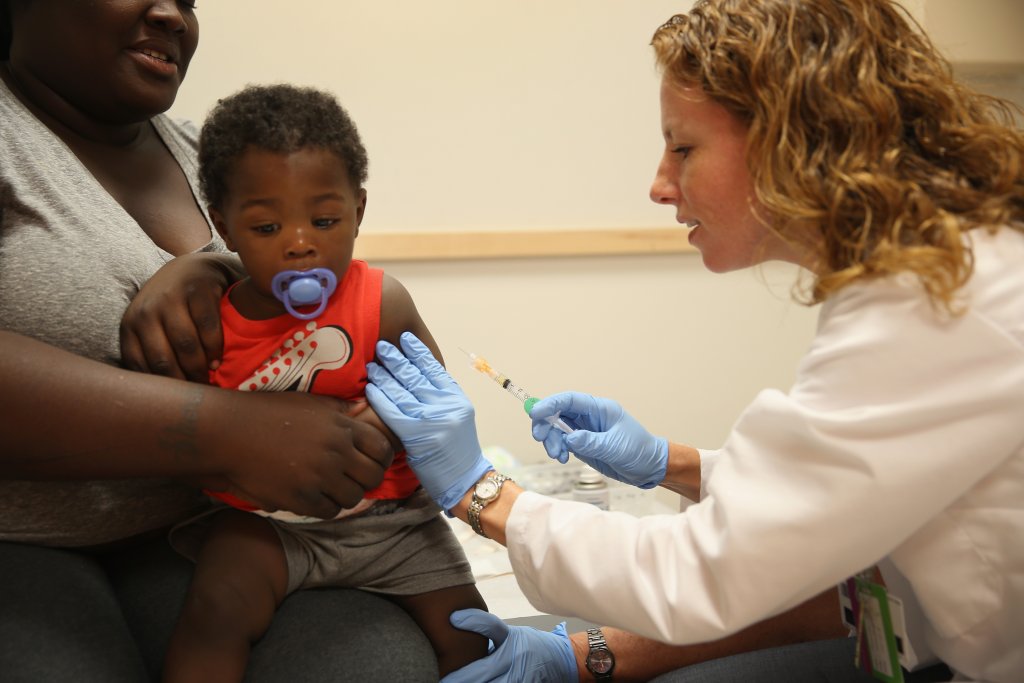India Ampah holds her son, Keon Lockhart, 12 months old, as pediatrician Amanda Porro M.D. administers a measles vaccination during a visit to the hospital. Photo by Joe Raedle/Getty Images.
An ongoing measles outbreak in and around Hennepin County has sickened at least 51 people, according to the latest Department of Health data. Most are unvaccinated children, and nearly one quarter of the people had to be hospitalized.
Separate data released by the Department of Health earlier this year underscores one of the risk factors behind the state’s worst measles outbreak since 2017: falling vaccination rates, which is a problem statewide but is especially acute within Minneapolis Public Schools.
From 2014 through 2019, 93% or more of Minnesota kindergartners had received a full course of the measles, mumps and rubella vaccine before they entered school. But a wave of social distrust and anti-vaccine sentiment pushed that number downward in subsequent years, with just 87% of kindergartners fully vaccinated against MMR at the start of the 2023-2024 school year.
The decline among kindergartners in Minneapolis Public Schools, however, has been much steeper. While MPS vaccination rates ran 1 or 2 percentage points lower than the statewide average prior to the pandemic, in 2023 just 75% of MPS kindergartners had received the full MMR vaccine.
That’s a 12-point deficit, with the data showing a drop of 6 percentage points in the past year alone.
It’s not clear what is behind the steep drop in Minneapolis. A recent Sahan Journal analysis of Hennepin County data found that “of the 20 schools with the lowest MMR vaccination rates, 11 are private Christian schools and seven are public charter schools that serve mostly Somali students.” Fewer than half of kindergartners are fully vaccinated against measles in at least 16 schools in the county.
Minnesota allows parents to opt their children out of vaccine requirements for personal, philosophical reasons. Most states allow religious exemptions only, while some — like New York and California — don’t allow non-medical vaccine exemptions at all.
The statewide non-medical MMR exemption rate was 5.2% in 2023, up from 2.6% in 2014. The exemption rate in Minneapolis Public Schools fell over the same period, from 2.4% to 1.5%, suggesting that some parents are simply ignoring the requirements — and that no one is enforcing them.
Vaccination rates at Minnesota’s charter schools typically run 12 to 14 points lower than at traditional public schools, a gap that has remained consistent since before the pandemic. Many charters in the Twin Cities cater to the Somali immigrant community, where vaccination rates tend to be low, owing in part to a years-long misinformation campaign waged by anti-vaccine activists who have targeted that community.
Minnesota Republican lawmakers have also stoked the flames of vaccine skepticism in recent years. At a House committee hearing in March, Rep. Natalie Zeleznikar, R-Fredenberg Township, denigrated vaccines as “poison that could kill you.”
State Sen. Nathan Wesenberg, R-Little Falls, referred to the COVID vaccine as a “death shot” during a 2023 rally at the State Capitol organized by anti-vaccine groups. At least seven other Republican lawmakers were also in attendance.
Measles is highly contagious. Patients initially develop flu-like symptoms, but if left untreated the disease can cause pneumonia, brain damage and long-term neurological problems, according to the Centers for Disease Control and Prevention.

